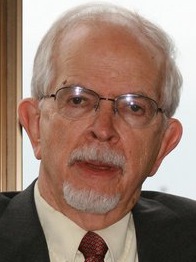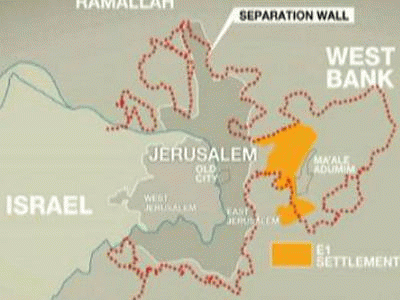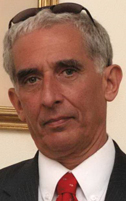Israel's response to the United Nations' overwhelming vote to admit Palestine to the UN was easily predictable. Israel had been waiting for just this moment to announce it would build a settlement in Area E1 (East One).
Prime Minister Benjamin Netanyahu was harshly rejected at the UN General Assembly, a stinging defeat he knew was coming which explains why he did not attend the GA personally.
On November 29, 2012, the General Assembly elevated Palestine to a new status as a non-member observer state. Such a rejection of Israel could not stand for one simple reason: Israel has other plans for Palestine, a long envisioned series of "worker bee" Palestinian bantustans located within an expanded state of Israel.
Netanyahu retaliated for the UN vote by announcing he had authorized the building of 3,000 new Jewish housing units in Area E1, a plot of land east of Jerusalem. Note carefully that E1 is east, not west of Jerusalem.
This move was no surprise. E1 has been a potential location for more Israeli settlements since 2005. E1 has been sitting on the "peace process" negotiation table for the past seven years, a "loaded gun" which, as any Hitchcock fan knows, has to be fired before the film concludes.
The "loaded gun" is Israel's "Doomsday Settlement." The reference, of course, is best remembered as the key plot moment in Stanley Kubrick's classic film, Dr. Strangelove and How I Learned to Love the Bomb, in which the Soviet Union's "Doomsday Machine" is triggered after a crazed U.S. Air Force General orders a nuclear attack on Soviet cities. (See below for a clip from the film.)
The Soviet response was designed to trigger an automatic nuclear response, bringing an end to the two nations.
Israel's "Doomsday Settlement" on E1 (see map above) "will render any prospective Palestinian contiguous state territorially impossible," according to Daniel Seidemann, the Israeli founder of Terrestrial Jerusalem.
Seidemann (above), a highly respected Israeli settler expert on territorial expansion, has condemned settlement construction on Area E1 as "the doomsday settlement."
Nicola Nasser, writing for Palestine Chronicle from his home in Bir Zeit in the West Bank of Palestine, explains the significance of Seidemann's "doomsday" designation:
"The site of some 4.6 square miles (12 square km) of this settlement on the eastern-most edge of eastern Jerusalem will close the only territorial link between the north and south of the West Bank and sever it from East Jerusalem, the prospective capital of the State of Palestine, thus undermining any viable and contiguous Palestinian state on the territories occupied by Israel in 1967 and turning the recognition of the UN General Assembly on November 29, 2012 as merely a Palestinian paper achievement."
Both the U.S. and the European Union had opposed the E1 plan since Israel first produced it in 2005, because, in a series of objections since 2005, Nicola Nasser reports:
"...they were alert to its potential undermining effect on the 'peace process.' Now, the five permanent members of the UN Security Council and the United Nations have all warned against the E-1 plan. The White House and U.S. State Department described the plan as 'unilateral,' 'counterproductive,' 'sets back' peace efforts, 'especially damaging to efforts to achieve a two-state solution,' 'complicate efforts to resume direct, bilateral negotiations' and 'risk prejudging the outcome' of such negotiations, and 'contrary to US policy.'"
This latest move by Israel calls to mind a dying Jimmy Cagney's Cody Jarrett character in the film, White Heat, who shouts to his dead mother,"Made it, Ma! Top of the world!"
With his latest gesture of defiance to the world, Benjamin Netanyahu could have been shouting to Israel's founding father, David Ben-Gurion, dead since 1973, "Made it, Mr. Prime Minister, we have finally reached the Jordan River!"
(Note: You can view every article as one long page if you sign up as an Advocate Member, or higher).







